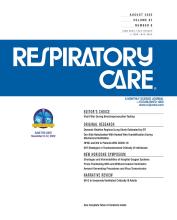This article requires a subscription to view the full text. If you have a subscription you may use the login form below to view the article. Access to this article can also be purchased.
Abstract
BACKGROUND: To analyze the role of PEEP on dynamic relative regional strain (DRRS) in a model of ARDS, respective maps were generated by electrical impedance tomography (EIT).
METHODS: Eight ARDS pigs submitted to PEEP steps of 0, 5, 10, and 15 cm H2O at fixed ventilation were evaluated by EIT images. DRRS was calculated as (VT-EIT/EELI)/(VT-EIT[15PEEP]/EELI[15PEEP]), where the tidal volume (VT)-EIT and end-expiratory lung impedance (EELI) are the tidal and end-expiratory change in lung impedance, respectively. The measurement at 15 PEEP was taken as reference (end-expiratory transpulmonary pressure > 0 cm H2O). The relationship between EIT variables (center of ventilation, EELI, and DRRS) and airway pressures was assessed with mixed-effects models using EIT measurements as dependent variables and PEEP as fixed-effect variable.
RESULTS: At constant ventilation, respiratory compliance increased progressively with PEEP (lowest value at zero PEEP 10 ± 3 mL/cm H2O and highest value at 15 PEEP 16 ± 6 mL/cm H2O; P < .001), whereas driving pressure decreased with PEEP (highest value at zero PEEP 34 ± 6 cm H2O and lowest value at 15 PEEP 21 ± 4 cm H2O; P < .001). The mixed-effect regression models showed that the center of ventilation moved to dorsal lung areas with a slope of 1.81 (1.44–2.18) % points by each cm H2O of PEEP; P < .001. EELI increased with a slope of 0.05 (0.02–0.07) (arbitrary units) for each cm H2O of PEEP; P < .001. DRRS maps showed that local strain in ventral lung areas decreased with a slope of −0.02 (−0.24 to 0.15) with each cm H2O increase of PEEP; P < .001.
CONCLUSIONS: EIT-derived DRRS maps showed high strain in ventral lung zones at low levels of PEEP. The findings suggest overdistention of the baby lung.
Footnotes
- Correspondence: Gerardo Tusman MD, Department of Anesthesiology, Hospital Privado de Comunidad, Mar del Plata, Argentina. E-mail: gtusman{at}hotmail.com
See the Related Editorial on Page 1061
Dr Tusman wrote a patent regarding electrical impedance tomography and lung strain. Dr Madorno is partner and manager of MBMed SA. Mr Gogniat is currently employed by Medtronic Argentina. The remaining authors have disclosed no conflicts of interest.
This study was performed at the Hospital Veterinario Universitario de la Universidad de Buenos Aires, Buenos Aires, Argentina.
- Copyright © 2022 by Daedalus Enterprises
Pay Per Article - You may access this article (from the computer you are currently using) for 1 day for US$30.00
Regain Access - You can regain access to a recent Pay per Article purchase if your access period has not yet expired.











